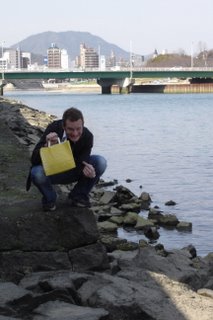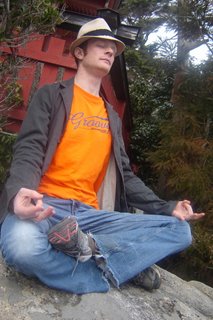Friday, after closing ceremonies at Ritto Nishi Jr. High (we cleaned the school top-to-bottom, the principal gave another depressing speech about the inexorable onward march of time, and a good time was had by all), we kicked off the nonstop madcap Spring Break by jumping on the first Shinkansen headed south. Destination?
No, not Shin-Osaka. Not Hakata either. The first gold train on that list goes straight to
 (hint: the leaf wrapping is inedible, but if you are dumb enough to eat some, it tastes kinda like mint) and leapt onto the Shinkansen. Two hours later…
(hint: the leaf wrapping is inedible, but if you are dumb enough to eat some, it tastes kinda like mint) and leapt onto the Shinkansen. Two hours later…
Now, I’ll be perfectly candid when I tell you I had no idea what to expect. My mental image of
So the first night was spent checking into our hostel, and then exploring the city a touch by night. The above picture was taken in the market district.
.  The next morning, we woke up early and took a streetcar (I wish I could say it was named Desire, I really do) to the
The next morning, we woke up early and took a streetcar (I wish I could say it was named Desire, I really do) to the
 This is the Bomb Dome, located just across the river from the
This is the Bomb Dome, located just across the river from the
 This one commemorates all the students that were pressed into service at the time of the explosion- human resources were low even before the explosion, and schoolkids were not exempt from assisting the war effort. A lot of them were in the target area when the bomb went off.
This one commemorates all the students that were pressed into service at the time of the explosion- human resources were low even before the explosion, and schoolkids were not exempt from assisting the war effort. A lot of them were in the target area when the bomb went off.
Across the river is the famous “Sayaka Memorial”- the little girl who believed that folding paper cranes would cure her of her radiation-induced leukemia. She didn’t manage to fold all the cranes she needed, so her classmates finished the job after she passed away, and built a statue in the
Here’s the main promenade. There’s more around in the
The Peace Museum tells an in-depth story of exactly what happened that morning, including video testimonies of the victims, artifacts that survived the bomb, medical supplies, keloid scars in formaldehyde, human shadows etched into concrete, steel doors twisted by heat and shockwaves, stopped watches (all at 8:15, the time of the blast)- a real-life hall of horrors. There’s also a wall covered in hundreds of letters- the Mayor of Hiroshima has written a formal protest every time a country tests a nuclear weapon. The manner of these letters are always the same- “Dear Mr. Ambassador of (The
Don’t get me wrong, though. The overall tone is one of rebuilding, and moving forward. It’s important that they burn that flame in hopes of nuclear disarmament, and that they keep writing letters, and that admission to the museum is so cheap that anyone in the world could come in. They just want people to know, to remember, and to first and foremost realize how destructive these weapons are. Not a whole lot of bitterness- in fact, as mentioned before, the city is mind-bogglingly optimistic. There’s a corridor in the shopping district where, as soon as the stores have closed for the night, entire TRIBES of street musicians set up and hold concerts (for free, mind you, as begging for money is outlawed without a permit) to gaggles of enthusiastic schoolgirls who sit in neat rows in front of their erstwhile rockstars. Not once did I get an askance look for being Western nor even disapproval when they asked me where I was from and I answered “ (which is both a bakery AND the Danish Consulate in
(which is both a bakery AND the Danish Consulate in
HEY LOOK! IT’S SAFE! ALL DONE TALKING ABOUT ATOMIC TRAGEDY!
So. Off the coast of
This is the island with the famous floating shrine-gate. It’s a beautiful place- mountainous, heavily forested, and undeveloped save for a thin strip around the edge of the island- everything else is little huts, temples and shrines along the paths up to the top. We climbed two out of the three mountains in less than a day, so they’re not craaazy big or anything, but they are QUITE nice. A slide-show follows, to illustrate the cool things on the island- I think it might serve me well to just get out of the way for a minute here. See you when you’ve flipped through the pictures.
So. Miyajima. Sacred Island, big gate, fun place. Nice, eh?
We found (halfway up the island) a Japanese hiker who lived in
So after a fun day in the woods, we hopped back on the Shinkansen and wound our way back to Shiga. I bid the girls goodnight and got four hours of sleep before the big trip began in earnest.
-fin-













No comments:
Post a Comment